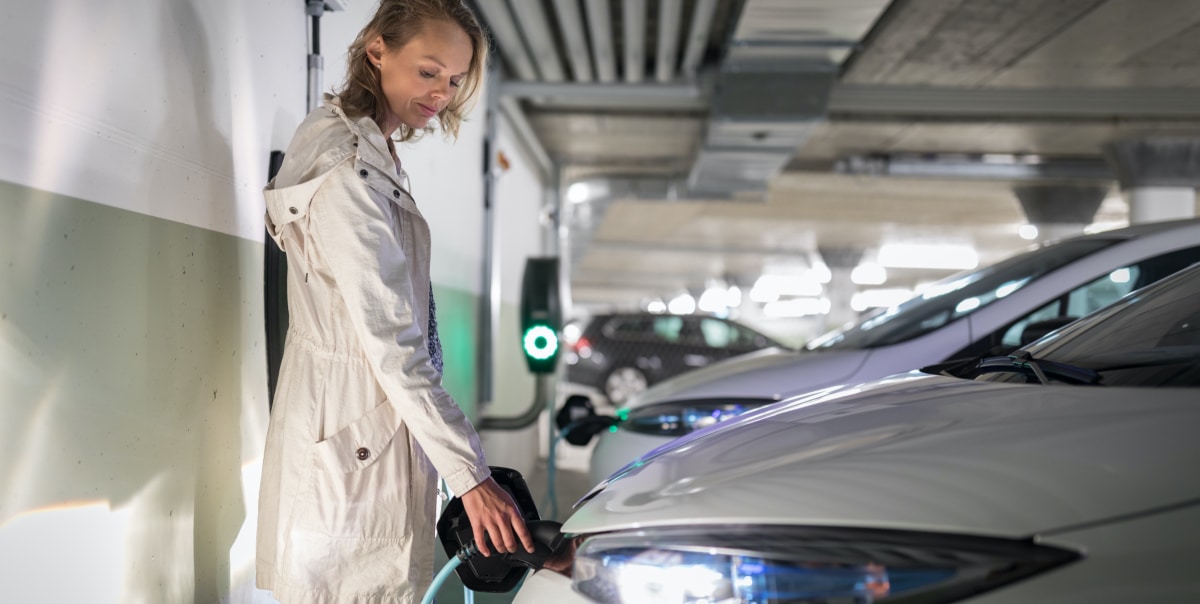Opportunities and Risks in Multifamily EV Charger Station Installations

5 Min. Read
The recent surge in demand for electric vehicles is only the beginning of a much bigger trend. It is clear that the demand for electric cars will continue to grow rapidly. EV charging can provide new revenue streams, increase resident satisfaction and add value to your property. The time will likely come when it is a competitive requirement. So, if you own a multifamily property, it makes sense to get ahead of the curve and install charging stations for your residents.
Multifamily charging is inherently complex with issues ranging from capacity constraints to extensive retrofits, and it’s key to understand and meet residents’ needs. This article covers these issues in detail below. Developing and following a detailed, sound practice is extremely important. Mistakes can be costly and affect tenant relations. If you lack expertise in such projects, you will need professional help.
To assist you, we provide an overview of multifamily EV charging stations for property owners. The focus is on issues and risks associated with multifamily EV charging and how to overcome them. Also at the end is a brief introduction of Qmerit, the leader in North American EV charging installations, and a great partner for your EV charger projects. But first, a brief summary of market demand.
Growth prospects for the market
There are approximately 26,000 charging stations in the US today, but by 2030, there will be a need for 8.7 million EV charging stations.
With a population of over 80 million, multifamily tenants are an untapped market for EVs.Tellingly, studies show that over 85% of EV charging takes place at home, but multifamily EV charging stations are scarce
A powerful example is EV-friendly California, where 50% of the population lives in multi-tenant housing.
Moreover, California charging infrastructure grew by 9% in the first quarter of 2020 alone.
Also notable is that many states and the federal government offer tax credits and other incentives for EV charging installations.
Unique challenges of multifamily EV charging stations
Because multifamily EV charging frequently involves existing buildings, it comes with built-in constraints. These include:
- Electrical infrastructure capacity for the new charging loads. The buildings’ existing panels, circuits and other infrastructure may not have sufficient capacity. Thus, they may involve costly retrofits.
- Infrastructure may be outdated.This is especially relevant in older buildings, which may require upgrades.
- Parking lots are usually designed for maximum vehicle capacity. They often lack electric closet space to expand electrical capacity.
- Tradeoffs may be required. For example, the best location for charging stations may be nearest the building entrance from the parking lot, but this may be a long distance from the electrical closet. That can add costs for trenching.
- Customer safety and accessibility. These are crucial to avoid injuries and liability.
Start with a strategy for multifamily EV charging stations
Going in, it is important to think through what you want to do with multifamily EV charging stations. Do you want to generate revenue with added fees? Do you want to provide a value-added service that will allow you to charge higher rents? Estimating the return on investment can help you determine what kind of charger installation you can afford.
Also, determine residents’ charging needs. How long can they wait for a charge? You need to make sure they will use the service.
Finally, determine your internal competencies to plan and install EV charger stations. If you do not have those capabilities, engage an outside experienced in the field. Involve them from the start for best results.
This article assumes you will use outside help.
Types of EV charging stations and their applications
Level 1
These are the simplest option. Typically, they use an existing household 120-volt circuit and require some panel and conduit work, as well as wiring. The downside is charging duration, which can be up to 20 hours.
The cost of Level 1 systems range from $300-$600 before labor, which adds $1000 to $1700. This can be much higher for multifamily.
Level 3
Level 3 chargers are larger and are suited for multiple sites, like distribution centers or big box stores or malls. They require 480-volt service, a separate panel and special connectors.
Because they also use DC current, they require work with the local utility to provide new service.
Notably, this level is the fastest type, capable of charging an EV in as little as 30 minutes.
It is also the most expensive option and can range from $20,000 for equipment and parts, with labor adding up to $50,000 more.
Level 2
Level 2 chargers make sense for multifamily EV charging stations. They offer a good combination of cost and charging time. Equipment can run from $250 to $1000,
In addition, they require a dedicated 240-volt, 100A service. There may be significant panel work as well as conduit, wiring and connectors. Installation costs can run into the thousands if there is a need for new service.
Importantly for multifamily users, Level 2 chargers can charge an EV overnight.
Project management to mitigate risks
Once you have decided on the type and model of charger, it is time to plan and execute the project. There are discrete steps to follow:
- Retain the service of professionals in EV charging. These are complex projects, and mistakes can be costly.
- Allow for expansion in the future if possible. Planning ahead can save future costs.
- Carefully pre-survey existing conditions.Engage the contractor to do this.
- Involve the local utility from the beginning.Service changes need to be considered and priced in.
- Prepare an installation plan. Or better, have the contractor do it.
- File proper permits with local authorities.Failure to do so can be costly in time and money. The contractor should do this to clearly establish responsibility for permitting.
- Have the contractor work closely with the manufacturer. Avoid misunderstandings before they cost money.
- Communicate with residents. Let them know what is coming and when. Educate them on the system. Sell the benefits.
- Make sure you are fully informed on all costs.Stay involved from the beginning to the sign-off. Meet formally with the contractor at least weekly.
- Have an agreement.Make sure that there is a clear written agreement with the contractor on scope of work, schedule and all costs. Be sure to involve your legal counsel.
- Include future expansion. Take advantage of future expansion projects to build in EV charging from the start at far less cost.
- Make sure to plan for safe resident accessibility and signage.
Summary
Multifamily EV charging stations are a great opportunity to increase revenues and the marketability of your properties.
But there are risks in the process. You can mitigate them with a careful planning process and by hiring a company with a track record of success in EV chargers.
Qmerit is that company. We are the leading installer of EV charging stations in homes and multifamily properties in the U.S. With a long track record and deep experience in EV charging, Qmerit will stay with you from start to finish to navigate your multifamily project to success.
You can rest easy knowing that our certified installers will do the job right. In addition, our exclusive purchasing program will generate substantial savings for parts and equipment for your project.
For more information, contact us today.
